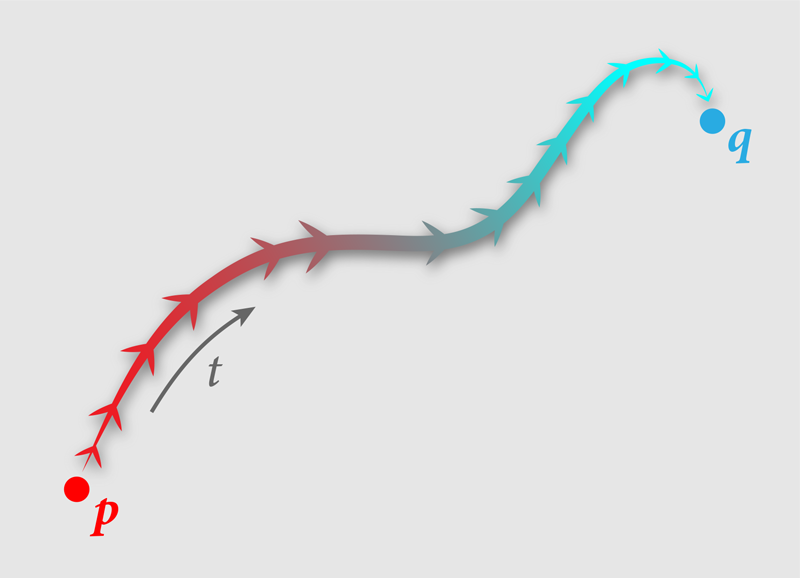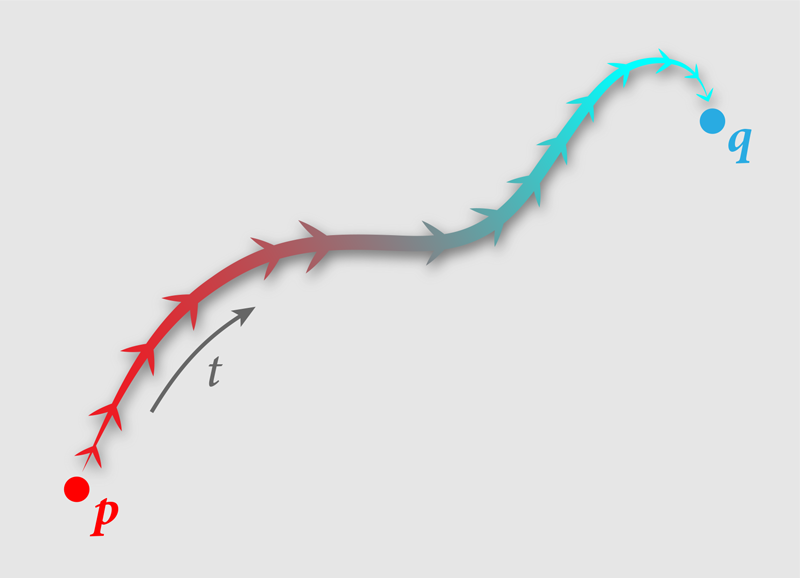Taking Smooth Steps Toward Equilibrium
No physical system is truly isolated. Even when a system is left “untouched,” interactions with its environment will affect its state and generically drive it toward thermal equilibrium, as encapsulated by the classical laws of thermodynamics. How exactly this “thermalization” occurs in complex systems remains an active area of research; what is clear is that thermalization as a dynamical process is ubiquitous. In a new theoretical study, Matteo Lostaglio at the University of Amsterdam and the Delft University of Technology, Netherlands, and Kamil Korzekwa at Jagiellonian University, Krakow, Poland, take this fact as a starting point to explore what happens to small systems en route to thermalization [1, 2]. Focusing on the regime in which a system interacts weakly with a large environment, Lostaglio and Korzekwa offer three findings: a complete set of constraints that all thermalization processes need to fulfill; a decomposition of a thermalization process into elementary components; and an algorithm that outputs a recipe for achieving any desired thermalizing transformation by piecing together these elements. The results could show physicists the optimal thermalizing paths between one thermodynamic state and another—a useful ingredient in heat engines and other applications.
The earliest theoretical developments in thermodynamics uncovered the classical zeroth, first, second, and third laws, which sketched out certain basic features of the physical world that distinguish macroscopic thermodynamic phenomena from the microscopic motion and interaction of particles and fields. These features include the concepts of heat and thermal equilibrium as well as the increase of entropy (or disorder), which were vital to figuring out what levers of control were available for achieving a particular desired state. More recently, researchers have developed more fine-grained and sophisticated descriptions for quantum thermodynamics with a particular focus on small quantum systems (see, for example, Ref. [3]).
A prominent treatment of thermodynamics describes the continuous evolution of a quantum system over time using a type of differential equation called a master equation [4]. An alternative approach, called thermal operations, abstracts away the continuity aspect and instead models processes as discrete transformations between two points in time [5, 6]. These operations can be engineered to achieve certain goals—such as optimizing the performance of a quantum-scale engine or refrigerator—by bringing a physical system in contact with a heat bath (a large system that maintains its own internal temperature) and making the two interact in carefully chosen ways. The resulting processes include thermalization—the system reaching thermal equilibrium with the bath—but also a rich variety of other possibilities, such as the counterintuitive outcomes that only quantum systems can produce. One may imagine all these possibilities as approaches to thermalization via any of a diverse collection of paths.
While this discrete model has an advantage over the continuous approach in that its solutions are more general, the system-environment interactions necessary to change a system from one state to another can be complex and difficult to determine. (Here, “state” refers to the collection of energy-level populations of a quantum system, that is, the probabilities with which it can be found in various levels.) Subsequent work has identified precise mathematical conditions—called thermomajorization—for thermal operations to be feasible in different contexts [6–9]. However, these conditions reveal little about how to implement such transformations.
The central contribution of Lostaglio and Korzekwa is providing a connection between the time-continuous and discrete-operational descriptions for a system weakly coupled to a large thermal environment. They also derive a family of entropy-production inequalities that supplant the standard second law by a more fine-grained requirement. The duo focus on a class of continuous processes where the system interacts with a thermal environment that is “forgetful”: the environment (initially in equilibrium) has a brief energy exchange with the system and then instantaneously relaxes back to equilibrium before its next exchange with the system. Mathematically, such processes are described by so-called Markovian master equations.
Lostaglio and Korzekwa identify a version of thermomajorization that is compatible with such a continuous treatment, determining which pairs of states can be connected by feasible continuous Markovian processes. They provide efficient algorithmic methods to check this relation for any given pair of states, to chart out all the final states reachable from a given initial state, and to explicitly construct for each feasible pair a connecting process comprising a sequence of particularly simple operations called elementary thermalizations. Each of these basic steps consists of partially thermalizing two energy levels of the system at a time (Fig. 1) [10]. In addition to involving only two-level interactions, these operations are also more direct than general thermal operations, which can take the system on circuitous routes toward equilibrium. These properties make elementary thermalizations amenable to efficient numerical optimization.
Going forward, it is worth noting that thermodynamics is ultimately a theory of control, describing what type of transformations nature allows when we have access only to macroscopic control variables. The picture described here so far is of a passive nature: it describes systems left to their own devices. The permitted control is limited to connecting and disconnecting parts of the system to the environment’s thermalizing influence. Ultimately, a more general modular theory could describe a larger set of elementary operations that are amenable to a continuous treatment but not limited to partial thermalization; some progress in this direction has already been achieved [11].
The appeal of Lostaglio and Korzekwa’s model lies in its explicit incorporation of time-continuous dynamics and its focus on modular operations. Thermalization features in thermodynamic protocols across the board, be they simplified theoretical toy models for information erasure, in the context of Landauer’s principle, or thermodynamic engine cycles [12]. Being able to modularize this ubiquitous process for small quantum systems is thus a valuable step forward. Besides the obvious question of including true “quantumness” in the description (in the form of quantum superposition between energy levels), it would also be interesting to see if a similar modularization can be applied when multiple heat baths are present at the same time but active control is still absent, as is the case for systems that support nonequilibrium steady states. Such explorations may pave the way toward incorporating the full power of general, non-Markovian processes in a continuous, modular description.
References
- K. Korzekwa and M. Lostaglio, “Optimizing thermalization,” Phys. Rev. Lett. 129, 040602 (2022).
- M. Lostaglio and K. Korzekwa, “Continuous thermomajorization and a complete set of laws for Markovian thermal processes,” Phys. Rev. A 106, 012426 (2022).
- F. Binder et al., Thermodynamics in the quantum regime, Fundamental Theories of Physics (Springer, 2018)[Amazon][WorldCat].
- R. Kosloff, “Quantum Thermodynamics: A Dynamical Viewpoint,” Entropy 15, 2100 (2013).
- D. Janzing et al., “Thermodynamic cost of reliability and low temperatures: tightening Landauer’s principle and the second law,” Int. J. Theor. Phys. 39, 2717 (2000).
- M. Horodecki and J. Oppenheim, “Fundamental limitations for quantum and nanoscale thermodynamics,” Nat. Comm. 4, 2059 (2013).
- F. Brandão et al., “The second laws of quantum thermodynamics,” Proc. Natl. Acad. Sci. USA 112, 3275 (2015).
- M. Lostaglio et al., “Description of quantum coherence in thermodynamic processes requires constraints beyond free energy,” Nat. Comm. 6, 6383 (2015).
- G. Gour et al., “Quantum majorization and a complete set of entropic conditions for quantum thermodynamics,” Nat. Comm. 9, 5352 (2018).
- M. Lostaglio et al., “Elementary thermal operations,” Quantum 2, 52 (2018).
- C. Perry et al., “A sufficient set of experimentally implementable thermal operations for small systems,” Phys. Rev. X 8, 041049 (2018).
- R. Landauer, “Irreversibility and heat generation in the computing process,” IBM J. Res. Dev. 5, 183 (1961).





